|
|
|
|

HOTEI 布袋
God of Contentment & Happiness
Origin = Chinese Taoism / Buddhism Chinese Name = Bùdài, Budai or Putai Said to be an incarnation of Miroku Bodhisattva.Miroku is known in China as Mílè Púsà, Miluo Fo, or Miluo Pusa. Hotei is known in the West as the Fat Buddha or Laughing Buddha. Hotei is one of Japan’s Seven Lucky Gods. Reportedly based on a real person. Commonly depicted bald, smiling, with a big belly, bulging ears, and a large sack and fan in his hands. Associated Virtue = Magnanimity
|
SEVEN VIRTUES
Japan's Seven Lucky Gods are a popular grouping of deities
that appeared from the 15th century onward. The members of
the grouping changed over time, but a standardized set
appeared by the 17th century. In the 17th century, Japanese
monk Tenkai (who died in 1643 and was posthumously named
Jigen Daishi) symbolized each of the seven with an essential
virtue for the Shogun Tokugawa Iemitsu (1623-1650 AD).
The seven virtues are:
- Candour (Ebisu)
- Fortune (Daikokuten)
- Amiability (Benzaiten)
- Magnanimity (Hotei)
- Popularity (Fukurokuju)
- Longevity (Juroujin)
- Dignity (Bishamonten)
References: Flammarion Iconographic Guide - Buddhism
|
Hotei 布袋. Male. The god of contentment and happiness, guardian of children, and patron of bartenders. Hotei 布袋 has a cheerful face and a big belly. He is supposedly based on an actual person, and is widely recognized outside of Japan as the Fat, Laughing Buddha. He carries a large cloth bag over his back (Nunobukuro 布袋, lit. = cloth bag), one that never empties, for he uses it to feed the poor and needy. It includes an inexhaustible cache of treasures, including food and drink. Indeed, the Japanese spelling of “Hotei” literally means “cloth bag.” He also holds a Chinese fan called an oogi 扇 (said to be a “wish giving” fan -- in the distant past, this type of fan was used by the aristocracy to indicate to vassals that their requests would be granted). Hotei is most likely based on the itinerant 10th-century Chinese Buddhist monk and hermit Budaishi (d. 917), who is said to be an incarnation of Miroku Bodhisattva (Maitreya in Sanskrit).
Hotei is sometimes shown surrounded by a group of small children, romping and squealing in delight around his rotund shape. In recent times, Hotei is also referred to as the patron saint of restaurateurs and bartenders. When one over eats and over drinks, one may sometimes jokingly attribute it to Hotei’s influence. For a few more details on Hotei, click here for story by Jennifer Polden.
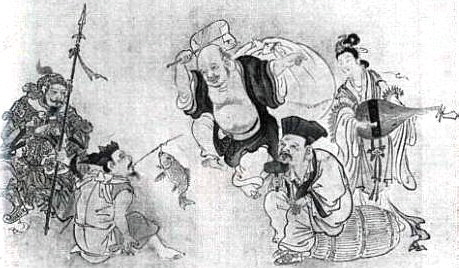
Five of the Gods of Fortune 五福神図, by Kanō Tanyū 狩野探幽 (1602-1674).
One of the oldest extant drawings of an abbreviated assemblage of the group.
Ebisu (fish), Daikokuten (rice bale), Bishamonten (long spear),
Benzaiten (musical instrument), Hotei (big bag). Photo from this J-site.
I’m not sure, but I think this piece is at the University Art Museum,
Tokyo National University of Fine Arts & Music.
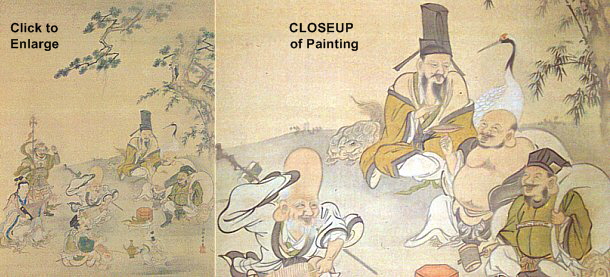
The earliest extant pictorial example of all seven gods in the standard set.
Seven Gods of Good Fortune, the standard set, by Kano Yasunobu 狩野安信 (1613-1685). Hanging scroll,
ink and colors on silk, H = 139 cm, W = 97.4 cm. University Art Museum, Tokyo National University of Fine
Arts and Music. Above photos from art historian Patricia Graham.

HOTEI IN JAPANESE MYTHOLOGY
Below Text Courtesy of JAANUS
www.aisf.or.jp/~jaanus/deta/h/hotei.htm
Chinese = Budai. A semi-legendary itinerant 10th-century Buddhist monk who became a popular subject in Chinese and Japanese ink painting. His real name is said to have been Qici 契此 (Jp. = Keishi), whose biography is found in the 908 Song Gaosenzhuan 宋高僧伝 (Jp. = SOU KOUSOUDEN) or the "Legends of High Priests of the Song Dynasty." He lived on Mt. Siming 四明 in Mingzhou 明州, Fenghua 奉化, where he frequently strolled through a nearby town carrying his large cloth bag (Ch. = Budai; Jp. = Hotei 布袋). Thus he earned his affectionate nickname, "Priest Budai." Budai's air of "enlightened innocence" led him, like Hanshan and Shide Kanzan Jittoku 寒山拾得, to be admired as an exemplar of Zen values. Although originally he was said to have filled his bag with anything he encountered on his wanderings, later Zen interpretations speak of Budai's "empty bag." Ironically, in Japanese popular culture Budai's bulging bag and contented appearance led to his inclusion in the Seven Gods of Good Fortune. Budai was also thought to have been an incarnation of Maitreya (Miroku 弥勒). In painting Budai is shown with sparse hair, a smiling face, a large bare belly, loose garments and carrying a bag and wooden staff. In later paintings he is shown in a variety of poses, usually seated or sleeping on his bag, but also dancing, walking or pointing upwards at the moon. In Edo period painting Budai is frequently pictured together with groups of playing children. Early Chinese examples include paintings by Liang Kai 梁楷 (Jp: Ryoukai, mid-13c, Kousetsu 香雪 Museum, Koube), Muqi 牧谿 (Jp: Mokkei, late 13c), and Yintuoluo 因陀羅 (Jp: Indara, late 14c, Nezu 根津 Museum, Tokyo), while a plethora of Japanese versions range from works by Mokuan 黙庵 (?-1345) to Ogata Kourin 尾形光琳 (1658-1716) to numerous mitate-e 見立絵 prints in ukiyo-e 浮世絵. <end JAANUS quote>
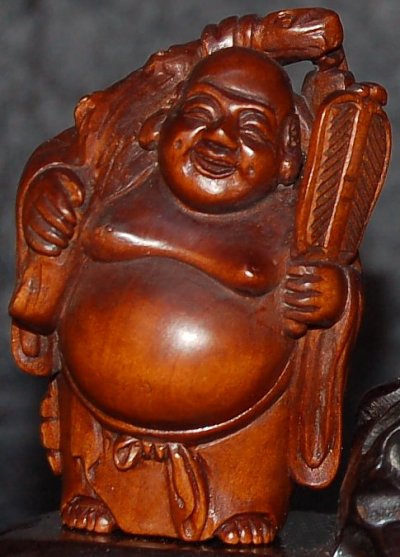
Hotei -- Netsuke available in our estore
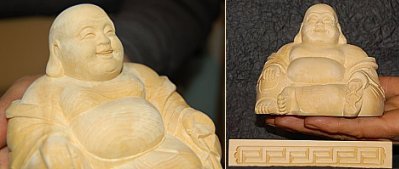
One of the Hotei statues in our estore
|
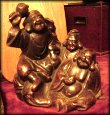
Daikoku, Ebisu, & Hotei
Yellin Collection
|
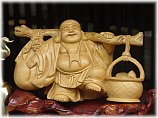
Hotei in
Kamakura Shop Window
|
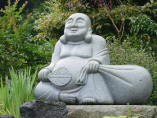
Hotei stone statue
Zenyo-in (Inatori City)
|
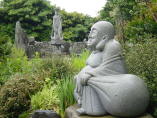
Hotei stone statue
Zenyo-in (Inatori City)
|
|
|
|
|
|
|
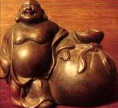
Yellin Collection
|
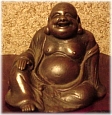
Yellin Collection
|

Private Garden, MN USA
Metal, 2006
|
 
(L) Private Garden, Kamakura
Japan 1920, Stone
(R) Hase Dera, Kamakura
|
|
 Says the Flammarion Iconographic Guide: Hotei could be the Chinese hermit Budaishi (d. 917), who was thought to be an incarnation of Maitreya; the latter is venerated in some Zen monasteries of the Oubaku sect (as at Manpuku-ji Temple in Kyoto) by the name of Hotei, the “Miroku with the Large Belly.” He is represented as a Buddhist monk: bald, unshaven, smiling, with a huge belly. He holds a non-folding fan in the right hand, and leans on a large sack which contains endless treasures, a sort of horn of plenty for his followers. He is also sometimes confused with Warai-Hotoke (smiling Buddha) or with Fudaishi (Japanese version of the name of the Chinese hermit Budaishi) when he is assigned to guard monastery libraries. In this case he is accompanied by his two “sons.*” In Japan, the image of Hotei is often made as a toy for pulling or tilting. When it has wheels, the toy is called kuruma-sou (the rolling monk). In some representations in Japan, Hotei has an eye drawn on his back, a symbol of universal vision. Says the Flammarion Iconographic Guide: Hotei could be the Chinese hermit Budaishi (d. 917), who was thought to be an incarnation of Maitreya; the latter is venerated in some Zen monasteries of the Oubaku sect (as at Manpuku-ji Temple in Kyoto) by the name of Hotei, the “Miroku with the Large Belly.” He is represented as a Buddhist monk: bald, unshaven, smiling, with a huge belly. He holds a non-folding fan in the right hand, and leans on a large sack which contains endless treasures, a sort of horn of plenty for his followers. He is also sometimes confused with Warai-Hotoke (smiling Buddha) or with Fudaishi (Japanese version of the name of the Chinese hermit Budaishi) when he is assigned to guard monastery libraries. In this case he is accompanied by his two “sons.*” In Japan, the image of Hotei is often made as a toy for pulling or tilting. When it has wheels, the toy is called kuruma-sou (the rolling monk). In some representations in Japan, Hotei has an eye drawn on his back, a symbol of universal vision.
* Footnote: A legend relates, against all the evidence, that Fudaishi was the inventor of the buildings intended to contain the sutras (rotating libraries, called kyōdō in Japan), and built by the so-called Azekura-zukuri technique. His two sons, shown clapping their hands and laughing, are sometimes called Fuwaku (or Fuken) and Fukon (or Fujō). Sculptures at Kōmyō-ji Temple in Kamakura, and at Daikoku-ji Temple in Kyōto. <end Flammarion quote>

SOURCES
- Butsuzō zui 仏像図彙 (Illustrated Compendium of Buddhist Images). Published in 1690 (Genroku 元禄 3). A major Japanese dictionary of Buddhist iconography. Hundreds of black-and-white drawings, with deities classified into categories based on function and attributes. For an extant copy from 1690, visit the Tokyo Metropolitan Central Library. An expanded version, known as the Zōho Shoshū Butsuzō-zui 増補諸宗仏像図彙 (Enlarged Edition Encompassing Various Sects of the Illustrated Compendium of Buddhist Images), was published in 1783. View a digitized version (1796 reprint of the 1783 edition) at the Ehime University Library. Modern-day reprints of the expanded 1886 Meiji-era version, with commentary by Ito Takemi (b. 1927), are also available at this online store (J-site). In addition, see Buddhist Iconography in the Butsuzō-zui of Hidenobu (1783 enlarged version), translated into English by Anita Khanna, Jawaharlal Nehru University, New Delhi, 2010.
- JAANUS. Japanese Architecture and Art Net Users System. A wonderful online dictionary compiled by the late Dr. Mary Neighbour Parent. It covers both Buddhist and Shinto deities in great detail. Over 8,000 entries. Written in English, yet presenting all key terms in Japanese.
- Digital Dictionary of Buddhism -- HOTEI (sign in with user name = guest)
- Buddhism (Flammarion Iconographic Guides)
 , by Louis Frederic, Printed in France, ISBN 2-08013-558-9, First published 1995. A highly illustrated volume, with special significance to those studying Japanese Buddhist iconography. Includes many of the myths and legends of mainland Asia as well, but its special strength is in its coverage of the Japanese tradition. Hundreds of accompanying images/photos, both B&W and color. Frederic uses many images from the Butsuzō zui (see prior entry) , by Louis Frederic, Printed in France, ISBN 2-08013-558-9, First published 1995. A highly illustrated volume, with special significance to those studying Japanese Buddhist iconography. Includes many of the myths and legends of mainland Asia as well, but its special strength is in its coverage of the Japanese tradition. Hundreds of accompanying images/photos, both B&W and color. Frederic uses many images from the Butsuzō zui (see prior entry)
- Essentials of Buddhist Images: A Comprehensive Guide to Sculpture, Painting, and Symbolism. By Kodo Matsunami. Paperback; first English edition March 2005; published by Omega-Com. Matsunami (born 1933) is a Jōdo-sect 浄土 monk, a professor at Ueno Gakuen University, and chairperson of the Japan Buddhist Federation. He received the government's Medal of Honor (褒章 hōshō), Blue Ribbon, for his achievements in public service. Says Matsunami: “Bishamonten protects from disaster and bodily harm. Daikoku satisfies the deisre for food. Benzaiten represents sexual desire. Hotei brings laughter, and Ebisu grants wealth.
- Tobifudo Deity Dictionary. Ryūkozan Shōbō-in Temple 龍光山正寶院 (Tokyo). Tendai Sect. Jump to its Hotei page.
- The Seven Lucky Gods of Japan
 , by Chiba Reiko. Charles E. Tuttle Co., 1966. Pages 35-38. , by Chiba Reiko. Charles E. Tuttle Co., 1966. Pages 35-38.
- UCLA Center for East Asian Studies, Educational Resources from teacher Samantha Wohl, Palms Middle School, Summer 2000. See Wohl’s Materials List (based on Chiba Reiko’s book).
LEARN MORE

This is a side page
Return to Seven Lucky Gods Main Page
|
|